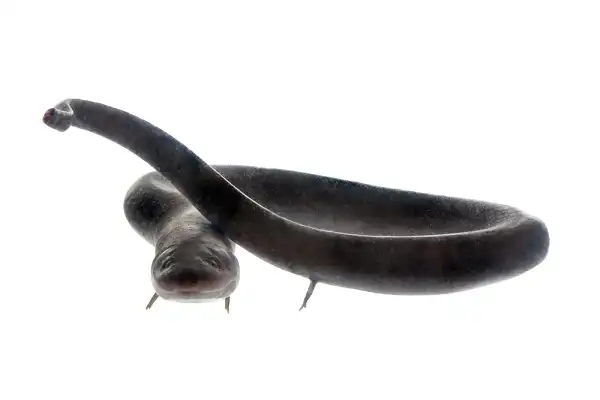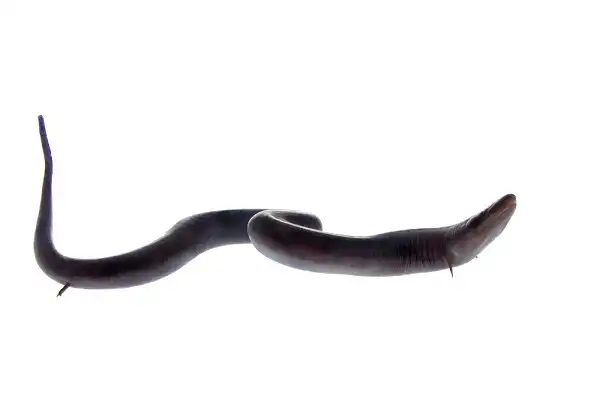Amid the lush rain forests of the Democratic Republic of Congo lies a creature that strikes fear into even the most experienced adventurers – the Congo Snake. With its brownish-gray scales, reddish neck, and pale underside, this venomous viper is mysterious and dangerous. Its powerful jaws contain short curved fangs which can inject haemotoxic venom capable of bringing down even large prey with alarming speed. As one amongst many species from Africa’s diverse array of wildlife, understand more about how it lives in nature and how to stay safe during an encounter with this remarkable creature.

Congo Snake Description
The Congo Snake is a species of venomous viper found in the Democratic Republic of Congo. Its body is marked with brownish-gray scales and reddish coloring on its neck. Its pale underside allows it to blend in with the surrounding foliage when hunting. It is important for adventurers to be aware of their surroundings when visiting areas populated by Congo Snakes. If encountered, it is important to remain still and avoid any sudden movements that might startle them. Though they typically shy away from humans, it’s still essential to take all safety precautions necessary should an encounter occur.
Congo Snake Habitat
The Congo Snake inhabits a variety of habitats in the rainforests of Central Africa, including low-lying areas near rivers, swamps, and wetlands. They prefer moist climates with plenty of shade, making them well adapted to their dense forest environs. Due to their excellent camouflage capabilities and shy demeanor, they are quite difficult to spot in the wild. Congo Snakes can inhabit different types of vegetation depending on their age and sex; juveniles often live in thick grasses or small shrubs while adults tend to be found in more open areas near trees and logs. During colder months they will seek shelter under rocks and logs to keep warm. The snake is also known for taking shelter within tree hollows, inside bird nests, and even inside termite mounds for protection from predators. In addition to its natural habitat, the Congo Snake is sometimes kept as an exotic pet in captivity. As such, there are a few key things that must be taken into account when caring for these snakes at home. They must have a safe enclosure that offers plenty of ventilation and darkness as well as hiding spaces like rocks or logs. Additionally, Congo Snakes require a regular food source such as rodents or birds to be provided appropriately sized prey items at least once a week.
Congo Snake Diet
The Congo Snake has an opportunistic diet, eating a variety of small mammals and birds. They typically hunt by striking their prey with their short curved fangs and injecting a haemotoxic venom that paralyzes the animal. This venom is not only capable of bringing down larger prey, but it is also effective at killing smaller animals in a matter of minutes. In addition to hunting, these snakes can also scavenge for food or eat carrion if necessary. The Congo Snake’s diet consists mostly of rodents such as mice, rats, squirrels, and shrews; lizards such as geckos and skinks; frogs; insects like grasshoppers, beetles, and caterpillars; as well as small birds. They have also been known to occasionally feast on fish from streams or rivers near their habitats. Due to the snake’s territorial nature, it will usually inhabit an area for extended periods of time so its diet may vary based on what is available from season to season.

Congo Snake Size
The Congo Snake is an average-sized snake, reaching up to approximately 4.5 to 5.5 feet in length when fully grown. Females tend to be slightly larger than males, with a thicker body girth and longer tails. The patterning can also vary from individual to individual depending on the region in which it lives, making it difficult for predators to distinguish them from the surrounding environment. In terms of weight, adults typically range anywhere between 1 and 2 kilograms (2 to 4 pounds). Juveniles however are much lighter, weighing only around 150 grams (5 ounces) at birth before rapidly gaining weight during their first year of life. The snake’s large size gives it the physical strength necessary to take down large prey items.
Congo Snake Lifespan
The Congo Snake is a relatively long-lived species, with an average lifespan of 10 to 20 years in captivity. In the wild, however, their life expectancy is much shorter and depends heavily on their environment. Factors such as the availability of food, climate, and predation can significantly reduce their natural life expectancy. Their lifespan can be further extended with proper care and nutrition. Providing them with a healthy diet consisting of appropriately sized prey items at least once a week is essential for ensuring they remain healthy and active throughout their lives. Additionally, it’s important to create an enclosure that offers plenty of ventilation and darkness as well as hiding spaces like rocks or logs for security. Lastly, providing fresh water every day and maintaining proper temperature levels at all times will help ensure your pet snake remains active and healthy for many years to come.

Congo Snake Behavior
Congo Snakes are typically shy and solitary animals, preferring to spend most of their time tucked away in hiding spots or curled up in cool shaded areas. When disturbed, they will often try to flee rather than fight. However, if given no other option they will raise the front of their body and flatten it out while hissing loudly as a form of defense. Congo Snakes are usually active at night when predators are less likely to be present and the temperature is cooler. During the day, they can often be found resting in burrows or under rocks, logs, and other debris. They may also take shelter from extreme weather conditions by retreating into hollow trees or crevices between rocks. These snakes can travel long distances in search of food; this is particularly true during the dry season when prey may not be as abundant in their immediate vicinity.
Due to their territorial nature, Congo Snakes will usually inhabit an area for extended periods of time which allows them to become familiar with its resources and food sources. Additionally, they will often return to the same hideouts after feeding in order to digest their meals more comfortably. In terms of mating behavior, male Congo Snakes are known for being quite aggressive towards one another; even rivaling cobras in their competitive displays! Females tend to be more docile, however; rarely engaging in fights with each other unless food or shelter is scarce. While most mating takes place during the wet season due to increased prey availability and humid temperatures that better suit both sexes’ thermoregulatory needs, individual snakes may mate year-round depending on local conditions and competition levels among males.
Congo Snake Speed
The Congo Snake is a surprisingly swift species and can reach speeds of up to 10 mph over short distances. They are able to move quickly and efficiently by using their long, muscular body to undulate across the ground while propelling themselves forward with the aid of their flexible ribs. In addition to their impressive speed, Congo Snakes are also very agile and can maneuver around obstacles with ease. Unlike other snakes, they possess several small scales on the underside of their bodies which gives them extra traction when needed. This allows them to change direction quickly as well as climb steep hills and even small trees with relative ease! By combining both speed and agility, the Congo Snake is able to outmaneuver its predators in order to escape danger or pursue prey.

Congo Snake Hunting
Congo Snakes are adept hunters and use a variety of tactics to capture their prey. They have excellent vision and hearing, which gives them an edge in locating unsuspecting animals from far distances. Additionally, their flexible bodies allow them to squeeze through tight spaces and around obstacles with ease; this helps them position themselves for the perfect strike. Once a Congo Snake has spotted its target, it uses its long body to coil up around the prey before quickly striking out with both fangs and claws. This attack usually occurs in less than a second, giving the animal no chance to escape. After subduing its victim, the snake will constrict around it until it stops moving or breathing; this ensures an easier meal for digestion later on. If there is competition for food sources in its environment, a Congo Snake may also employ another hunting tactic known as “stalking”. This involves patiently following its prey from a distance until an opportunity presents itself for capture. Once the animal is close enough, the snake will then make its move with lightning speed and accuracy!
Conclusion
The Congo Snake is a remarkable species that combines speed, agility, and stealth to successfully hunt prey in its environment. It is an impressive predator that can outmaneuver even larger animals due to its long body and flexible ribs which allow it to move quickly on land. In addition, the snake also possesses excellent vision and hearing; enabling it to accurately locate unsuspecting animals from far distances. Mating for the Congo Snake usually occurs during the wet season, but individual snakes may mate year-round depending on local conditions and competition levels among males. The species is also very social and rarely engages in fights unless food or shelter is scarce.
Frequently Asked Question

